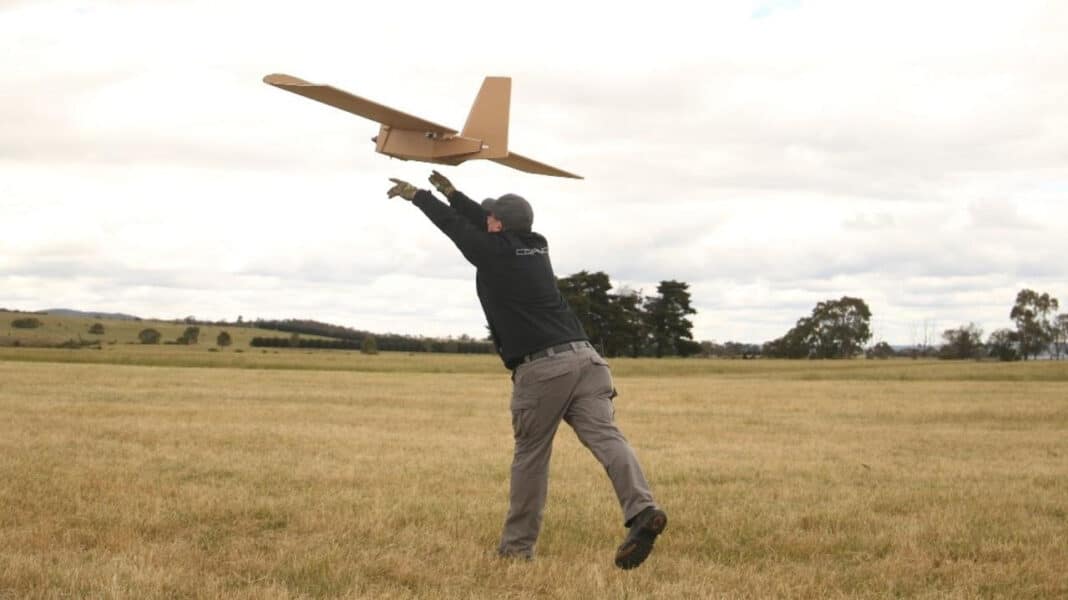Recycled Australian cardboard has become a vital military weapon in Ukraine’s war with Russia. The flat-pack cardboard drone has become an unexpected thorn in the side of Russia’s high-tech fighter pilots.
According to the Australian Army Defence Innovation Hub, the wood fibre industry now supplies Ukrainian forces with up to 100 cardboard drones monthly as part of a total AU $30 million aid package. Wood Central understands that the supply agreement for the cardboard drones is AU $1 million.
Drone technology, initially developed for military use, offers logistics, delivery and disaster relief opportunities. Now, civilian technologies are guiding military applications.
The Australian-based SYPAQ Systems is behind the low-cost drones – classified in military terms as ‘expendable drone technology.’
Announced in 2020, the Corvo Precision Payload Delivery System (PPDS), drones come flat-packed, can be launched by hand or catapult and fly up to 100km from it’s launching site.
At the time, CEO of SYPAQ Amanda Hold said, “The PPDS is an Australian capability that will help the Ukrainian people defend their country and is proof of the world-leading autonomous systems capabilities in Australian industry.”
“This capability is the result of an innovation journey with Army and the Defence Innovation Hub, and demonstrates the importance of collaboration between Defence and industry on capability development.”
According to Defence Minister Richard Miles, the cardboard drones have boosted Australia’s international reputation, with the Australian Defence Force now looking to use the drones.

Ukrainian forces used the drones to attack an airfield in Kursk Oblast in western Russia on August 27. The attack reportedly damaged a Mig-29 and four Su-30 fighter jets, two Pantsir anti-aircraft missile launchers, gun systems, and an S-300 air surface-to-air missile defence system.
According to Vasyl Myroshny Chenko, Ukraine’s Ambassador to Australia, the drones “are assembled as if they were an item from Ikea.”
The cardboard drones are in intelligence, surveillance, and reconnaissance missions for medical drops and lethal attacks.
Speaking to Channel 7, foreign affairs commentator Dr Keith Suter said, “Cameras can be placed inside the drones for surveillance.”
Drones have become an integral part of the war in Ukraine. Ukrainian forces regularly employ them to target both personnel and vehicles. Besides the cardboard drones, most drones used in the conflict are off-the-shelf models customised to carry grenades.
Long-range strikes against targets deep inside Russia have also been carried out recently by Ukrainian drones.
The Corvo PPDS is an expendable drone intended to deliver supplies and equipment into areas traditional logistics capabilities cannot reach.
Its design principles revolve around several factors, including the production cost, airframe material, weight, payload, range, deployment and ease of use.
Other considerations include the reliability of the operating software and the ability to fly the drone in various weather conditions.
“Generally, small drones offer high-resolution imagery for reconnaissance in a rapidly changing theatre of war,” says Dr Paul Cureton, director of post-graduate research and lecturer in design at UK’s Lancaster University.
In an article published in the Conversation, Dr Cureton said, “the Corvo drone has a high-resolution camera that provides images covering a large area, transmitting footage back to its user in real-time.”
The drones can carry 5 kg of weight, have a wingspan of 2 m and a range of 120 km at a reported cost of $5300 – far more cost-effective than conventional weapons.
Dr Cureton said waxed cardboard was ideal; it offered weather resistance, flat-pack transportation (measuring 510 mm by 760 mm) and a lightweight airframe, enabling longer flight times.
Fixed-wing drones also offered longer ranges than rotor-based drones; the wings generated the lift, and the airframe had less drag, making them more energy efficient. They can also fly at higher altitudes with a 60 km/h cruise speed.
Radar involves the transmission of electromagnetic waves, and these are reflected off any object back to a receiving antenna. Cardboard is generally harder to detect by radar, but its components, such as the battery, can be seen.
But the Corvo drone is likely to have a small signature. Radar-absorbing materials are needed to have full stealth properties. These polymers have absorbing qualities to avoid radar detection.
“Another design principle is the swarming capability of the drone,” Dr Cureton said.
“Swarms of drones can overpower air defence systems through sheer volume or can be used as decoys in counterintelligence operations,” he said.
“Swarms are highly reliant on the development of artificial intelligence, which is still an embryonic research area.”







